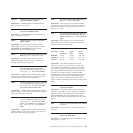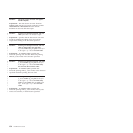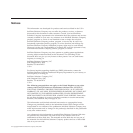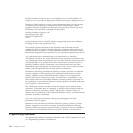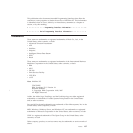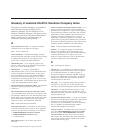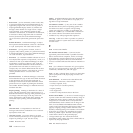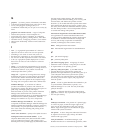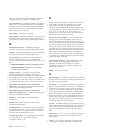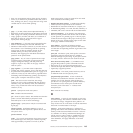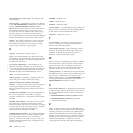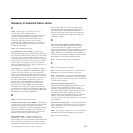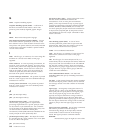G
graphics. (1) Charts, pictures, illustrations, and tables
created from fundamental drawing units such as lines,
curves, and polygons. (2) Images, text, or a
combination of both that you can put on an overlay by
name.
graphical user interface (GUI). A type of computer
interface that presents a visual metaphor of a
real-world scene, often of a desktop, by combining
high-resolution graphics, pointing devices, menu bars
and other menus, overlapping windows, icons and the
object-action relationship. Contrast with command line
interface.
I
icon. (1) A graphical representation of a choice or
object for the user to select. An icon can represent
something a user wants to work with, such as a
document, file, application, or user-created object or
list. An icon can also represent an action a user wants
to do. (2) A graphical symbol displayed on a screen
that a user can select to call a function or software
application.
image. (1) An electronic representation of an original
document or picture produced by a scanning device or
created from software. (2) A pattern of toned and
untoned pels that form a picture.
image cell. A portion of an image that saves storage
by defining only part of a raster pattern. Each image
cell must also contain information that defines the
placement of its raster pattern in the complete image.
An image cell can repeat so that it fills a defined area.
InfoPrint Manager. (1) A solution of software
products and hardware products. The solution can
supplement or replace the offset presses and copiers in
print shops with high-quality, non-impact,
black-and-white or process-color printers. InfoPrint
Manager takes documents from creation to the
published and kitted product. (2) In InfoPrint Manager
and InfoPrint XT software publications, InfoPrint
Manager for Windows or any of its components.
InfoPrint Manager for Windows. The software
component of InfoPrint Manager. InfoPrint Manager for
Windows handles the scheduling, archiving, retrieving,
and assembly of a print job and its related resource
files. It also tracks the finishing and packing of the
printed product.
initial value document. Synonym for default document.
Intelligent Printer Data Stream (IPDS). (1) An
all-points-addressable (APA) data stream that enables
users to position text, images, and graphics at any
defined point on the printed page. (2) Information that
the host sends to IPDS printers. This information
generally contains basic formatting, error recovery, and
character data, and enables the printers to make
decisions. (3) An architected host-to-printer data stream
that contains both the data (text, image, graphics, and
bar codes) and controls the definition of how to present
the data. IPDS provides a device-independent interface
to control and manage APA printers.
International Organization for Standardization (ISO).
An organization of national standards bodies from
various countries established to promote development
of standards to facilitate international exchange and
services, and develop cooperation in intellectual,
scientific, technological, and economic activity.
IPDS. Intelligent Printer Data Stream.
ISO. International Organization for Standardization.
J
JCL. Job control language.
JES. Job Entry Subsystem.
job control language (JCL). A language of control
statements used to identify a computer job or describe
its requirements to an operating system.
Job Entry Subsystem (JES). (1) An IBM licensed
program that receives jobs into the system and
processes all output data that is produced by jobs. (2) A
z/OS subsystem that receives jobs into the system,
converts them to an internal format, selects them for
execution, processes their output, and purges them
from the system.
job ID. A local or global identifier that identifies a job
to a job submitter, administrator, operator, or to
InfoPrint Manager or to z/OS. See local job identifier,
global job identifier.
jogging. A function that allows the printed output
pages to be offset for easy separation of the print jobs.
See also offset stacking.
L
landscape orientation. The position of a printed page
on a sheet of paper, so that the longer edges of the
paper are the top and bottom of the page, and the
shorter edges of the paper are the sides of the page.
Contrast with portrait orientation.
line printer. A device that prints individual characters
in sequence from left to right, and top to bottom.
Contrast with page printer.
local job identifier. In InfoPrint Manager, a job
identifier that the server automatically generates, which
Glossary of selected InfoPrint Solutions Company terms 161
|
|
|
|
|
|
|
|
|
|
|
|
|
|
|
|
|
|
|
|
|
|
|
|
|
|
|
|



